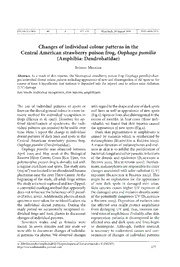
Changes of individual colour patterns in the Central American strawberry poison frog, Oophaga pumilio (Amphibia: Dendrobatidae) PDF
Preview Changes of individual colour patterns in the Central American strawberry poison frog, Oophaga pumilio (Amphibia: Dendrobatidae)
Short Communications SALAMANDRA 45 3 177-179 Rheinbach, 20 August 2009 ISSN 0036-3375 Changes of individual colour patterns in the Central American strawberry poison frog, Oophaga pumilio (Amphibia: Dendrobatidae) Ivonne Meuche Abstract. As a result of skin injuries, the Neotropical strawberry poison frog (Oophaga pumilio) chan- ges individual dorsal colour pattern including appearance of new and disintegration of old spots in the course of time. I hypothesize that melanin is deposited into the injured area to reduce solar radiation (UV) damage. Key words. individual recognition, skin injuries, amphibians. The use of individual patterns of spots or with regard to the shape and size of dark spots lines on the dorsal ground colour is a non-in- and lines as well as appearance of new spots vasive method for individual recognition in (Fig.). Spots or lines also disintegrated in the frogs (Henle et al. 997). However, for op- course of months. In four cases (three indi- timal identification of specimens, the indi- viduals), we found that skin injuries caused vidual patterns are required to be stable over the appearance of new spots (Fig.2). time. Here, I report the change in individual Dark skin pigmentation in amphibians is dorsal patterns of dark lines and spots in the caused by melanin which is synthesized by Central American strawberry poison frog, melanophores (Blaustein & Belden 2003). Oophaga pumilio (Dendrobatidae). A major function of melanophores and mel- Oophaga pumilio was observed between anin in skin is to inhibit the proliferation of April 2005 and May 2006 at the Biological bacterial, fungal and other parasitic infections Reserve Hitoy Cerere, Costa Rica. Here, this of the dermis and epidermis (Blaustein & polymorphic poison frog is dorsally red with Belden 2003, Mackintosh 200). Further- irregular dark lines and spots. The study area more, melanophores are responsible for color (505 m²) was located in an abandoned banana changes associated with solar radiation (UV) plantation near the river Hitoy Cerere. At the exposure (Blaustein & Belden 2003). This beginning of the study, all adult frogs within might be an explanation for the appearance the study area were captured and toe-clipped, of new dark spots in damaged skin areas. a convential marking method that apparently Skin injuries causes higher UV exposure of does not influence the behaviour of O. pumil- the damaged area and melanin absorbs some io (Pröhl 2002). Additionally, photos of each of the potentially dangerous UV (Blaustein specimen were taken for re-identification via & Belden 2003). Deposition of melanin into the individual dorsal patterns. During the the affected area might protect amphibians study period we occasionally recaptured in- from damaging UV and, thus, increase sur- dividual frogs and took photos to document vival rates of amphibians. Probably, after skin changes of individual patterns. regeneration melanin is decomposed in the Seventeen males and 52 females were affected area and dark spots and lines begin found. In seven females and one male we to disintegrate. Although, further research were able to document changes of individu- is necessary to understand causes and con- al patterns via photos. We observed changes sequences of changes of individual patterns © 2009 Deutsche Gesellschaft für Herpetologie und Terrarienkunde e.V. (DGHT) http://www.salamandra-journal.com 177 Short Communications Fig. 1. Changes of individual patterns of dark lines and spots on the red ground colour in the strawber- ry poison frog, O. pumilio. Numbers between the photos represents the number of days between two successive shots. Yellow arrows mark the affected areas. of spots and lines in the strawberry dart poi- mission to conduct the research in the Biologi- son frog, one consequence is obvious: indi- cal Reserve Hitoy Cerere (MINAE/SINAC permit vidual recognition based on dorsal patterns No. 37-2004-OFAU, 038-2005-OFAU, 004 ASP AC/AC), especially the staff at the Biological Re- should be accompanied by a second method serve for his support. For assistance in the field in O. pumilio. I would like to thank S. Becker, U. Freisen, F. Grözinger, U. Hartmann, A. Keller, A. Kro- Acknowledgements nhardt, B. Marschall, K. Moll, E. Müller, C. Ramenda, I. Schulz and Jairo. The German Thanks to the government of Costa Rica (MI- Academic Exchange Service (DAAD) supported NAE; Servicio de Parques Nacionales) for per- this work. 178 Short Communications Fig. 2. Appearance of new dark spots in damaged skin ares of one female O.pumilio. Numbers between the photos represents the number of days between two successive shots. Skin injuries (light circles) caused the appearance of new dark spots (green circles). References Mackintosh, J. A. (200): The antimicrobial pro- perties of melanocytes, melanosomes and me- Blaustein, A. R. & L. K. Belden (2003): Amphi- lanin and the evolution of black skin. – Journal bian defenses against ultraviolet-B radiation. of Theoretical Biology, 2: 0-3. – Evolution and Development, 5: 89-97. Pröhl, H. (2002): Population differences in fe- Henle, K., J. Kuhn, R. Podloucky, K. Schmidt- male resource abundance, adult sex ratio, and Loske & C. Bender (997): Individualerken- male mating success in Dendrobates pumilio – nung und Markierung mitteleuropäischer Am- Behavioral Ecology, 3: 75-8. phibien und Reptilien: Übersicht und Bewer- tung der Methoden; Empfehlungen aus Natur- und Tierschutzsicht. – Mertensiella, 7: 33-84. Manuscript received: 26 July 2008 Author’s address: Ivonne Meuche, Institut für Zoologie, Tierärztliche Hochschule Hannover, Bünteweg 17, 30559 Hannover, E-Mail: [email protected]. 179
